Detailing the Menu Bar
Overview
The Menu Bar consists of several command groups that allow for direct operations regarding the settings and the edition of the project. This chapter deals with each group of commands individually.
File menu
|
File menu |
|
New |
Is used to create a new project. See Creating a New Project. |
|
Open |
Is used to open previously created projects from the default project's folder. The location of the default project's folder can be modified in the "Designer Setup" option, accessed via the Tools menu. See Detail of MCL-Designer Setup and also Detail of Open. |
|
Close |
Is used to close the current project. If the project has unsaved data, a new window opens offering the possibility to save the changes (OK), close the project without saving the changes (No) or maintaining the project open (Cancel). |
|
Save |
Is used to save the current project in the previously defined project's folder. |
|
Save as |
Is used to save the current project with a new name or information. In the resulting window, fill in the available options. See Detail of Save as. |
|
Import |
Is used to import a project (.mprj file) into the folder you have selected as the "Project Directory" in the "MCL-Designer Setup" option (See Directories Tab). If the project was created with an older MCL-Designer version, you are provided with these options:
This feature is available if: •you are working with an MCL-Designer version that is higher than 4.4.3-1300, for projects created within MCL-Designer 4.4.3-1300 and higher. •you did not previously check the •you check the "Show 'Open with previous...' message after MCL-Designer updates" option located in the "Designer Settings" window. See Detail of MCL-Designer Setup.
|
|
Report |
Is used to create an account of a project's details such as all the specifications and screen shots. A report can be customized to include only the details specified in the "Report Settings" window. See Detail on Report. |
|
Exit |
Is used to exit MCL-Designer V4. |
|
Edit menu
|
Edit menu |
|
Undo |
Is used to cancel the last action. |
|
Redo |
Is used to cancel the last “Undo” action. |
|
Search |
Is used to execute a general search in the project. See Detail of Search below. |
|
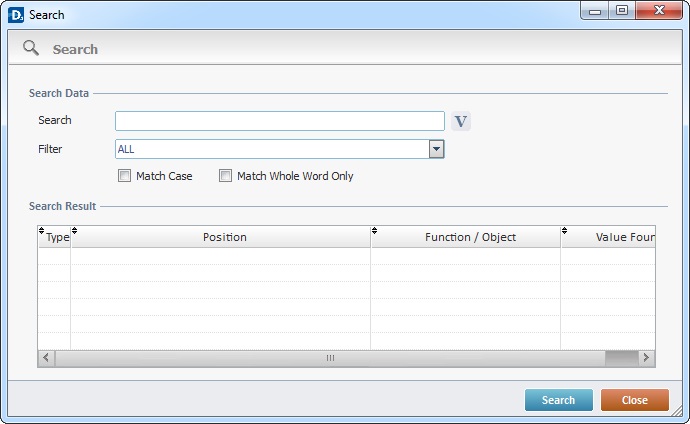
Of all these options, fill in the most appropriate ones to your search:
Search Data |
|
Search |
Enter the value to search or select it from within a variable by clicking |
Filter |
Use this option to limit the search field: All - Select this option to search for all the places where the string is found. Text - Select this option to search for all the places where the string is found as text. GOTO/Label - Select this option to search for the designated string in "Go to"/"Go to End of Action/Routine" processes or labels. Datafile - Select this option to search for the designated string in data file aliases being used by the project. Variable - Select this option to search for the designated string in variable names. The search result will return the locations where the searched variable is used. Variable (Var. write only) - Select this option to search for the designated string in variable names. The search result will return the locations where the searched variable is written. Com (Host/Aux/ODBC) - Select this option to search for the designated string in elements dealing with communication (Host / Aux / ODBC names). Barcode/RFID Profile - Select this option to search for the designated string in scanner/RFID profile names used in the project. Localization Tag - Select this option to search for the designated string within localization tags being used in the project. |
Match Case |
Check this option to take the designated string's uppercase and lowercase characters into account. |
Match Whole Word Only |
Check this option to enable an exact string search. |
After filling in the required options, click If you double-click a result, the corresponding "Actions" and "Properties" window open. |
|
Type column |
Displays the field or object where the designated string is found (ex: |
Position column |
Displays the location of the designated string. |
Function/Object column |
Displays the name of the process /object of the found string. |
Value Found column |
Displays the values found that match the designated string within the field/element it was found in. |
![]()
It is possible to run a direct/automatic search for a data file alias:
a. In the "Data Files" module, right-click the data file alias you want to search for (<test_DB> test_DB.DAT).
b. In the resulting right-click menu, select "Search".
The "Search" window opens with the search results (all the places where the data file alias is used).
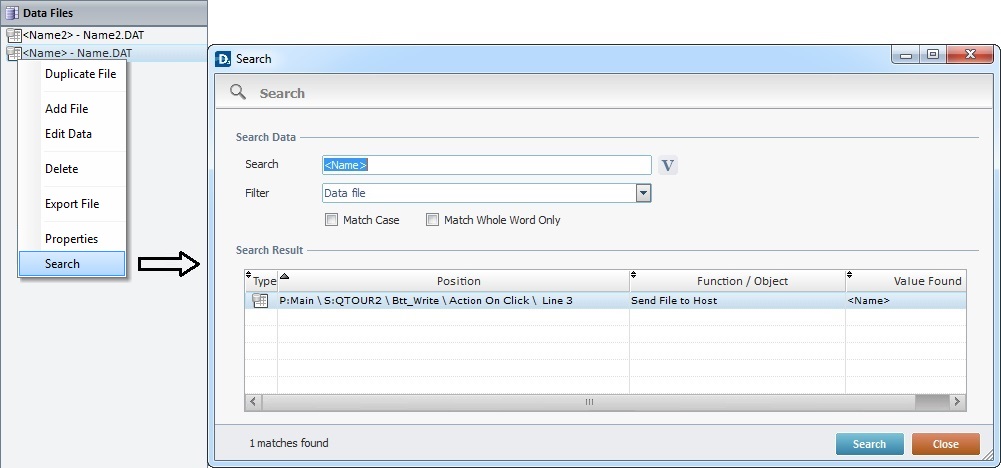
![]() This option does not search for specific data within the data file. To do so, open the data file, click
This option does not search for specific data within the data file. To do so, open the data file, click ![]() , then,
, then, ![]() and enter the specific data. See Search Data in an Opened Data File.
and enter the specific data. See Search Data in an Opened Data File.
Format menu
![]()
The rule for all object format commands is that the last selected object acts as a format template.
|
Format menu |
|
Align left |
Is used to align all selected objects with the utmost left object. |
|
Align Right |
Is used to align all selected objects with the utmost right object. |
|
Align Top |
Is used to align all selected objects with the utmost top object. |
|
Align Bottom |
Is used to align all selected objects with the utmost bottom object. |
|
Align Vertical Center |
Is used to align all selected objects vertically with the last selected object. |
|
Align Horizontal Center |
Is used to align all selected objects horizontally with the last selected object. |
|
Horizontal Space |
Is used to, evenly, align all selected objects horizontally. Select, at least, 3 or more objects. |
|
Vertical Space |
Is used to, evenly, space all selected objects vertically. Select, at least, 3 or more objects. |
|
Center Selection |
Is used to center all selected objects in relation to the screen. |
|
Center All |
Is used to center all objects in relation to the screen. |
|
Same Width |
Is used to shape all selected objects with the same width as the last selected object. |
|
Same Height |
Is used to shape all selected objects with the same height as the last selected object. |
|
Same Dimensions |
Is used to shape all selected objects with the same dimensions as the last selected object. |
|
Send Backward |
Is used to send the selected object behind the other objects of the same type. |
|
Bring Forward |
Is used to bring the selected object in front of other objects of the same type. |
|
Tools menu
|
Tools menu |
|
Library Manager |
Is used to import data files, global procedures, programs, screens and routines from a library. See Import from Library. |
|
Import From Designer V3 |
Is used to import projects developed in MCL-Designer V3. See Import MCL-Designer V3 Projects. |
|
MCL-Designer Setup |
Is used to configure certain settings of MCL-Designer V4. See Detail of MCL-Designer Setup. |
|
System Variables Setup |
Is used to directly attribute values to system variables that are used in the MCL-Designer Simulator. See Detail of System Variables. |
|
Icon Generator |
Is used to access the "Icon Generator" tool and create icons that will represent the application. See Detail of an Icon Generator window. |
|
Localization |
Provides access to a menu with further options regarding Localization. See Detail of Localization Options below. |
|
Themes |
Provides access to a menu with editing; importing and exporting options. See Detail of Theme Options. |
|
Restore from Autosaved Files |
Provides access to a window which displays the current project's restore points. See Restore Points window. |
|
Detail of Localization Options
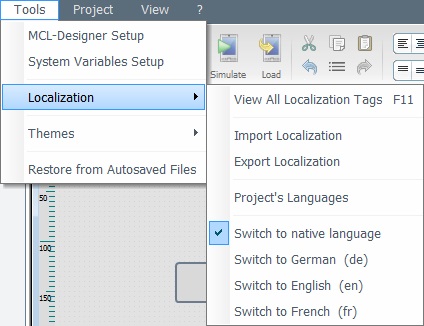
Localization provides access to the following options:
View All Localization Tags
If you select this option, a "Localization" window opens:
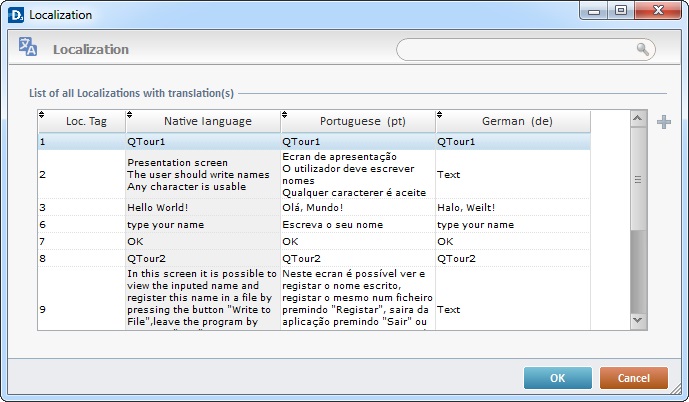
The window displays all the localization tags within the project as well as the native language values and the corresponding translated values.
Localization |
|
|
The search box allows you to search the localization tag, the native language value and/or the available languages values. To conclude the search, simply erase the value in the search box. |
Loc. Tag column |
Displays the localization tag's ID number. |
Native Language column |
Displays the text value within each tag. |
Available Languages columns |
Displays the corresponding translation to the native language's localization tag. There is a column for each of the previously selected languages available in the project. See Localization. |
|
If required, add localization tags. Click
Make sure that the "Loc. Tag" column is in ascending order so that you know which ID number to attribute to the new localization tag. Should you attribute an already in use "Loc. Tag", an error message is displayed. Click |
|
This button only becomes active after you have added a localization tag. You can only delete localization tags you have manually added |
This table is automatically generated and can be fed with imported language files. See Localization.
If needed,you can also edit any of the localization tags' fields. Double-click the field you want to edit, enter the new value and click ![]() to apply the modification(s).
to apply the modification(s).
Import Localization
Is used to import a Localization file. See To Import a Localization.
Export Localization
Is used to export a Localization file. See To Export a Localization.
Project's Languages
Is used to add or remove languages defined in the current project. It opens the "Localization" tab included in the project's properties. See Localization.
Switch to...
Is used to change the project's language utilizing a predefined list of languages. See Switch Languages.
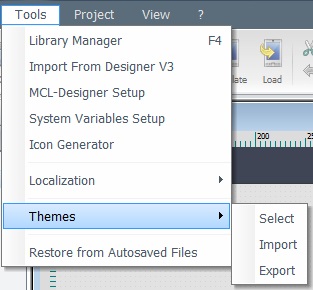
Themes provides access to the following options:
Select
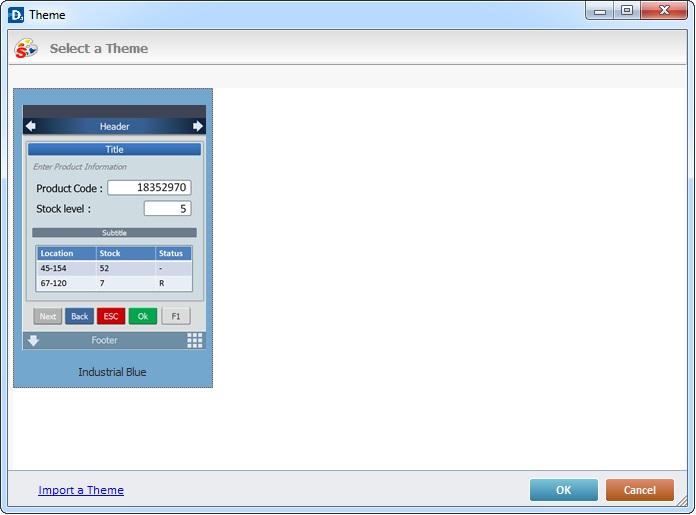
Is used to view the default themes and to import external themes by clicking ![]() (located on the bottom of the window).
(located on the bottom of the window).
Import
Is used to import external themes.
If you click this option, an OS browse window opens. Select the required theme files.
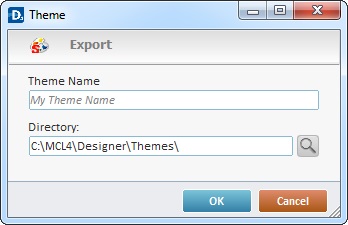
Is used to export a theme internal to MCL-Designer V4.
a. Enter the name of the theme to export (mandatory field).
b. Enter the name of the target location OR use ![]() to browse for a target location.
to browse for a target location.
c. Conclude the export operation by clicking ![]() .
.
Click each tab and fill in/check the available options, as required by your project.
General tab
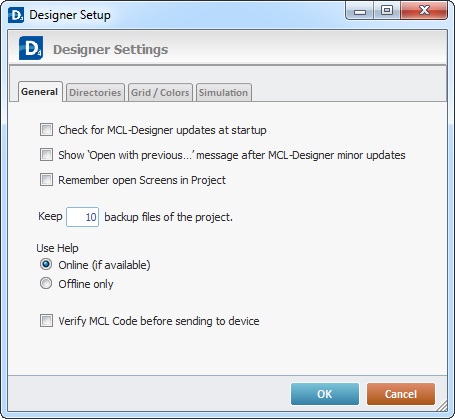
General tab |
|
Check for MCL-Designer updates... |
Check this option to enable an automatic check for updates on start-up. |
Show 'Open with previous...' message... |
Check this option if you want to have the "Open with previous Designer" message displayed after every MCL-Designer update, regardless of it being a major or minor update (a minor update means that there is no conversion - ex: a maintenance release). |
Remember open Screens in Project |
Check this option to reopen the screens left open in the previous session. |
Keep ...backup files of the project |
Define the number of backup files for a project.
•You save a project. •an autosave occurs (the autosave occurs automatically after the user inserts information/modifications and does not save the inserted data). •before converting an old project to a new version of MCL-Designer. •before generating or simulating a project. •you load a previous version of the current project. |
Use Help |
Select one of the following options: Online (if available) - If, at the time you want to access Help, there is no internet connection, you will be provided with the offline version. Offline only - When checked, this option only provides the Help File included in MCL-Designer. |
Verify MCL Code before simulating and sending to device |
Check this option to perform an MCL Code verification. This is recommended before simulating or sending it to a device. |
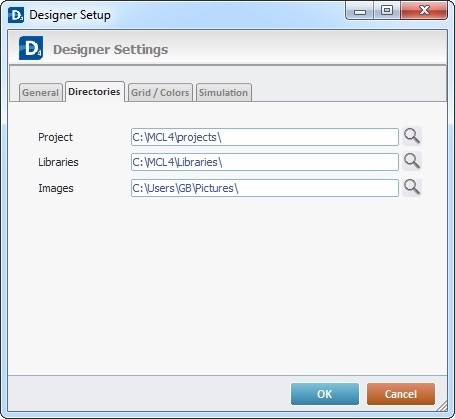
Directories tab |
|
Project |
Enter the project's directory location or click |
Libraries |
Enter the libraries directory location or click |
Images |
Enter the location for the current user's pictures directory or click |
Grid/Colors tab
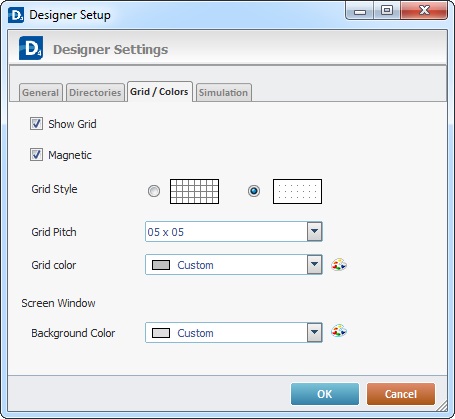
Grid/Colors tab |
|
Grid/Magnetic |
Define the grid specifications by checking “Show Grid” or “Magnetic” options. |
Grid Style |
Select the grid style preference, either squares or dots. |
Define the grid spacing by selecting the pitch in the drop-down list. |
|
Grid Color |
Define the grid color by selecting it from the drop-down list or customize it by clicking |
Background Color |
Define the background color for the screen window. Either select it from the drop-down list or customize it by clicking |
Simulation tab
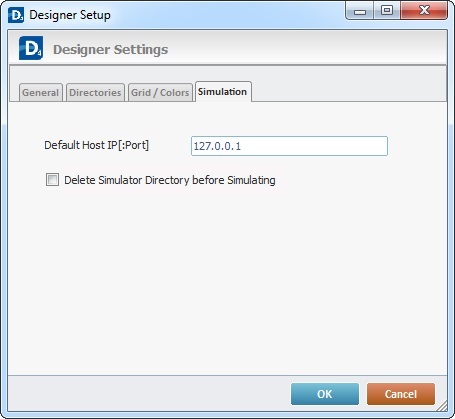
Simulation tab |
|
Default Host IP |
Define the default Host IP. |
Delete Simulator Directory before Simulating |
Check this option to delete test data before any simulation. |
After altering the desired values, click ![]() to proceed or
to proceed or ![]() to abort.
to abort.
Detail of System Variables Setup
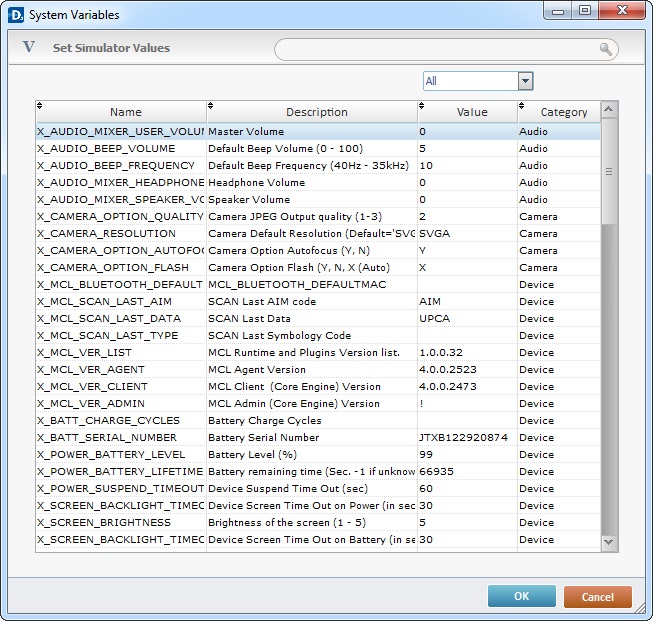
Enter new values in a variable field by double-clicking its “Value” field.
Execute variable name/description searches by entering query information in the "search box".
After altering the desired values, click ![]() to proceed or
to proceed or ![]() to abort.
to abort.
Project menu
|
Project menu |
|
Verify |
Is used to verify the consistency of the current project's MCL Code. If there are issues, a report window will open to display them. |
|
Generate |
Is used to generate the MCL Code. If there are issues, a report window is opened displaying them. See Detail of Project Verification Report. When you generate a project (click the "Generate" option and, then, save the project), you create an .mprj file. |
|
Simulate |
Is used to simulate and test the current project. See Simulating a Project. If there are issues, a report window is opened displaying them. See Detail of Project Verification Report. |
|
Load to Device |
Is used to send the MCL project to the device. The device must be on and connected via Windows Mobile Device Center connection, and the MCL Client waiting (in "Wait" mode). See Loading an Application/Project to a Device. |
|
Publish |
Is used to close the project version. This version can not be edited and is ready to be sent to the customer. See Publishing a Project. |
|
Generate Screenshots |
Is used to generate all screen shot images within the current project. When clicked, this option opens a window with the option to select the language for the project screen shots. See Detail of Generate Screenshots. |
|
Open Project's Folder |
Is used to open and view the project's directory. |
|
Properties |
Is used to display and edit current project properties. See Project Properties. |
|
Variables |
Is used to display a window with a variable list - a Floating Variable Select window. The content of this window, which is editable, depends on the currently active context (ex: a program, a screen, an object, etc.). See Detail of Variable Select windows. |
|
Detail of Project Verification Report
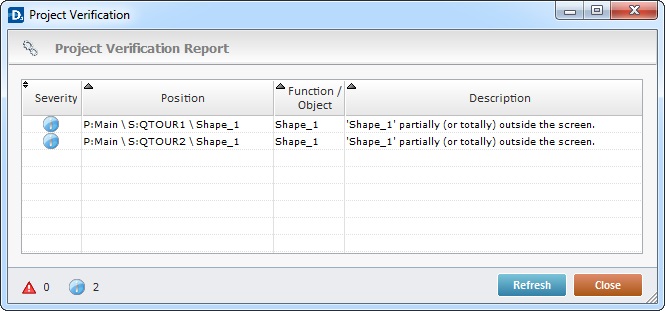
By double-clicking each error/warning line, the corresponding properties window is opened allowing corrections to be made. After editing the properties window, click ![]() to apply them.
to apply them.
Click ![]() to update the information or click
to update the information or click ![]() to close the window.
to close the window.
It is possible to filter the displayed information. Click ![]() to only display critical errors or
to only display critical errors or ![]() to view information errors in the project.
to view information errors in the project.
Detail of Generate Screenshots
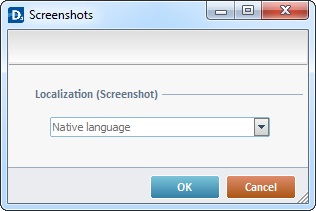
If the project includes languages other than the "native language" (see Localization), select the required one from the drop-down list and click ![]() .
.
This opens your project's screenshot destination folder where you can view the generated screenshot(s).
|
View menu |
|
Zoom |
Is used to select the zoom percentage which affects the viewing of the open screens in the Working Area (10%; 25%; 50%; 75%; 100%; 150%; 200%). |
|
Refresh |
Is used to refresh the Working Area. |
|
Show Thumbnail |
Is used to display the Thumbnail Section. |
|
Cascade |
Is used to display all opened screens in a cascade view, in the Working Area. |
|
Minimize All |
Is used to minimize all opened screens into the Thumbnail Section. |
|
Restore All |
Is used to open all minimized screens in the Thumbnail Section. |
|
Close Current |
Is used to close current screen. This can also be done by clicking the |
|
Close All |
Is used to close all open screens. |
|
The final area of this menu displays the name of the opened screens as well as the active screen (with the |
||
|
? menu |
|
MCL-Designer Help |
Used to access the MCL-Designer Help. Opens an CHM file if MCL-Designer V4 is offline or a web page if MCL-Designer V4 is online. See MCL-Designer Setup. |
|
Check for Updates |
Used to check for updates to MCL-Designer V4. Only works if the product is activated. See Check for Updates. |
|
About MCL-Designer |
Used to view the current version of MCL-Designer V4. See Detail of "About MCL-Designer" window below. |
|
Detail of "About MCL-Designer" window
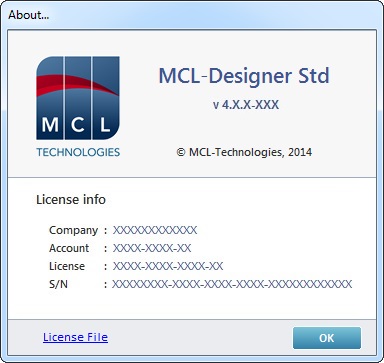
License/Subscription info |
|
Company |
The MCL-Mobility Platform company associated with MCL-Designer V4. See details in To Activate MCL-Designer V4. |
Account |
The MCL-Mobility Platform account number associated with MCL-Designer V4. See details in To Activate MCL-DesignerV4. |
License |
The license number associated with MCL-Designer V4. See details in To Activate MCL-Designer V4. |
S/N |
The software's serial number of the PC where MCL-Designer is installed. |
Clicking License File opens the license file folder. |
|
![]()
If you are using MCL-Designer V4 on "trial mode", the "About MCL-Designer..." window is different. It displays/offers:
•the current MCL-Designer V4 version.
•the days you have left in "trial mode"
•the possibility to activate a license/subscription so you can continue using MCL-Designer V4 in the "licensed mode", without restrictions.
For more information on the "trial mode", see MCL-Designer V4 Trial Mode.
